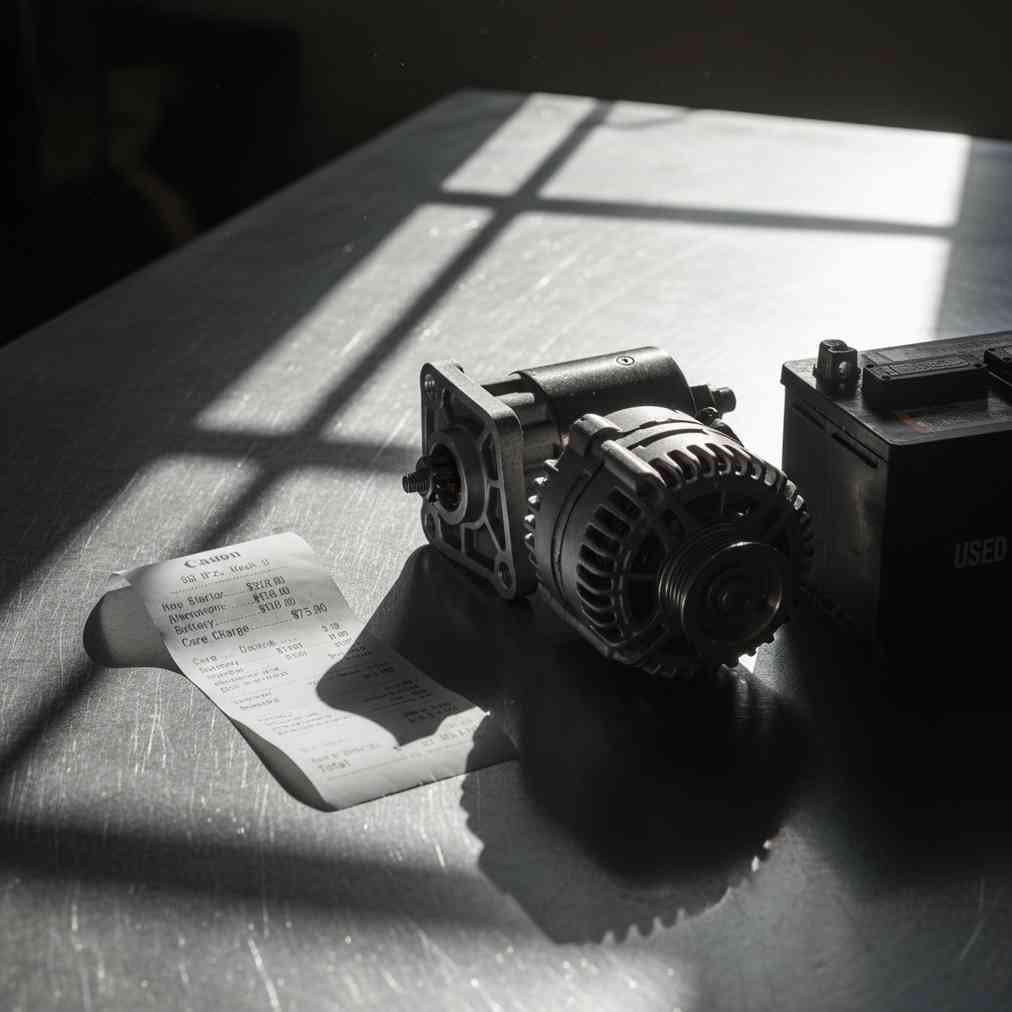What Is a Core Charge?
A core charge (also known as a core price or core deposit) is a refundable deposit added to the selling price of certain new or remanufactured automotive parts. This fee is charged to encourage customers to return their old, worn-out part, which is referred to as the “core”.
Think of it like a deposit on a soda bottle or propane tank: you pay the deposit upfront, and you receive the money back when you return the empty container. The core charge system works the same way with automotive parts, ensuring a steady supply of rebuildable parts while promoting environmental responsibility.
Why Do Core Charges Exist?
Understanding the purpose behind core charges helps explain why this system has become standard practice across the automotive industry:
Remanufacturing and Recycling
The primary reason for a core charge is to ensure a steady supply of old parts that can be disassembled, cleaned, repaired, and restored to their original function. This remanufacturing process allows companies to offer high-quality alternatives to brand-new parts at significantly lower costs.
Environmental Benefits
Core charges play a crucial role in environmental protection by keeping valuable materials like lead, copper, and steel out of landfills. The remanufacturing process requires up to 80% less energy compared to manufacturing parts from raw materials, making it an environmentally sustainable practice.
Legal Requirements
In many states, core charges are mandated by state legislature to promote recycling and proper disposal of automotive parts. These regulations ensure that hazardous materials are handled responsibly and don’t end up harming the environment.
Common Parts That Have Core Charges
Not all automotive parts carry core charges – only those that can be effectively remanufactured. Here are the most common parts that include core deposits:
| Part Type | Typical Core Charge Range | Why It Has a Core Charge |
|---|---|---|
| Starters | $25 – $75 | Contains valuable copper windings and rebuildable internal parts |
| Alternators | $25 – $100 | Copper windings, magnets, and electronic parts can be reused |
| Batteries | $10 – $75 | Lead-acid batteries contain hazardous materials requiring proper recycling |
| Brake Calipers | $15 – $50 | Metal housing can be machined and rebuilt with new seals |
| AC Compressors | $50 – $200 | Complex mechanical parts that can be rebuilt and tested |
| Power Steering Pumps | $25 – $75 | Internal mechanisms can be rebuilt with new seals and gaskets |
| Transmissions | $100 – $300 | Large, complex assemblies with many reusable internal parts |
Parts like brake pads, spark plugs, or air filters typically do not have core charges because they cannot be effectively remanufactured and are considered consumable items.
How Core Charges Work: Step-by-Step Process
Getting your core charge refund is straightforward when you understand the process. Here’s how it works:
Step 1: Purchase
When buying a qualifying part, you pay the price of the part plus the core charge deposit upfront. For example, a $150 alternator with a $75 core charge means paying $225 initially.
Step 2: Installation and Removal
After installing the new or rebuilt item, you must carefully remove the old, defective part (the core). This old part becomes your “ticket” to getting your deposit back.
Step 3: Preparation for Return
Before returning your core, make sure to:
- Drain any oil or fuel from the part
- Clean off excessive dirt and debris
- Ensure all essential parts are intact
- Keep your receipt or packing slip
Step 4: Return
Return the old core to the seller along with your receipt. The returned core must be in a fully rebuildable, undamaged condition and must be the exact part purchased. Most retailers require the core to be returned within 30 days of purchase, though California allows up to 45 days for lead-acid battery cores.
Step 5: Refund
Once the seller receives and accepts the core, your deposit is refunded either as cash or a credit to your account. The refund typically takes 5-10 business days after the part is received by the supplier.
Pro Tip: If you have the old part with you at the time of purchase, many clerks can waive the core charge entirely, meaning you avoid paying the deposit upfront.
Core Charge Amounts and What Affects Pricing
Core charge amounts vary significantly based on several factors. Understanding these variables helps you budget appropriately when purchasing automotive parts:
Factors That Influence Core Charges
- Part complexity: More complex parts like transmissions have higher core charges than simple alternators
- Material value: Parts containing precious metals or copper command higher deposits
- Remanufacturing cost: Parts that are expensive to rebuild typically have higher core charges
- State regulations: Some states mandate specific core charge amounts
- Market demand: High-demand cores may carry premium deposits
For those looking to sell their junk car or find replacement parts, understanding these pricing structures can help make informed decisions about repairs versus replacement.
Expert Tips for Handling Core Charges
Maximize your success with core charges by following these professional recommendations:
Documentation Is Key
- Keep the receipt: Always retain the original receipt showing the core charge
- Take photos of the core before installation if it’s in questionable condition
- Note any missing or damaged parts that might affect acceptance
Return Policies
- Return to the same retailer: While some stores accept cores purchased elsewhere, returning to the original seller guarantees the smoothest process
- Check specific acceptance criteria before purchase
- Understand timing requirements – most have 30-day windows
Quality Requirements
Manufacturers often have strict acceptance policies. Your core must meet these criteria:
- Housing must be crack-free and structurally sound
- Essential internal parts must be present (even if worn)
- Castings should be free from major damage
- Electrical connections should be intact
Common Core Charge Mistakes to Avoid
Avoid these common pitfalls that can cost you your core deposit:
- Losing your receipt: Without proof of purchase, getting your deposit back becomes difficult
- Waiting too long: Missing the return deadline means forfeiting your deposit
- Damaging the core during removal: Use proper tools and techniques to avoid cracking housings
- Returning wrong parts: The core must match exactly what you purchased
- Not checking acceptance criteria: Some cores are rejected for missing internal parts
Alternative Ways to Handle Old Parts
If you can’t return your core for the deposit, consider these alternatives:
Sell to Scrap Dealers
Many parts contain valuable metals that scrap dealers will purchase. While you might not get the full core charge amount, you can recover some value.
Visit Local Junkyards
Some junkyards near me purchase cores independently of retail transactions. This can be especially useful if you’ve missed return deadlines or have cores that don’t meet retail acceptance criteria.
Proper Disposal
If a part has no resale value, ensure proper disposal through:
- Municipal recycling programs
- Auto parts store take-back programs
- Licensed hazardous waste facilities (for batteries and certain electrical parts)
The Environmental Impact of Core Charges
Core charges represent more than just a business practice – they’re a crucial environmental protection measure. By incentivizing the return of old parts, this system:
- Reduces landfill waste by millions of pounds annually
- Conserves natural resources by reusing existing materials
- Prevents hazardous substances from contaminating soil and groundwater
- Reduces energy consumption in manufacturing processes
- Supports the circular economy in automotive manufacturing
According to recent environmental research, automotive recycling programs like core charges have prevented millions of tons of waste from entering landfills while creating sustainable business practices.
Future of Core Charges
As automotive technology evolves, particularly with the rise of electric vehicles, core charge systems are adapting:
Electric Vehicle Parts
EV parts like battery modules, electric motors, and inverters are beginning to carry core charges as remanufacturing processes develop for these newer technologies.
Digital Integration
Many retailers are implementing digital tracking systems that make core returns more efficient, reducing paperwork and processing times.
Expanded Programs
Core charge programs are expanding to cover more part categories as remanufacturing technology improves and environmental regulations become stricter.
Conclusion
Core charges aren’t a hidden fee or business trick – they’re a well-established system designed to promote recycling, reduce costs, and protect the environment. By understanding how they work and following proper procedures, you can take advantage of affordable remanufactured parts while getting your full deposit back.
Remember to keep your receipts, return cores promptly, and ensure they meet acceptance criteria. Whether you’re replacing a simple alternator or a complex transmission, understanding core charges helps you make informed decisions and save money on automotive repairs.
The next time you see a core charge on your receipt, you’ll know exactly what it is and how to handle it properly. This knowledge not only saves you money but also contributes to a more sustainable automotive industry for everyone.





Leave a Reply
You must be logged in to post a comment.